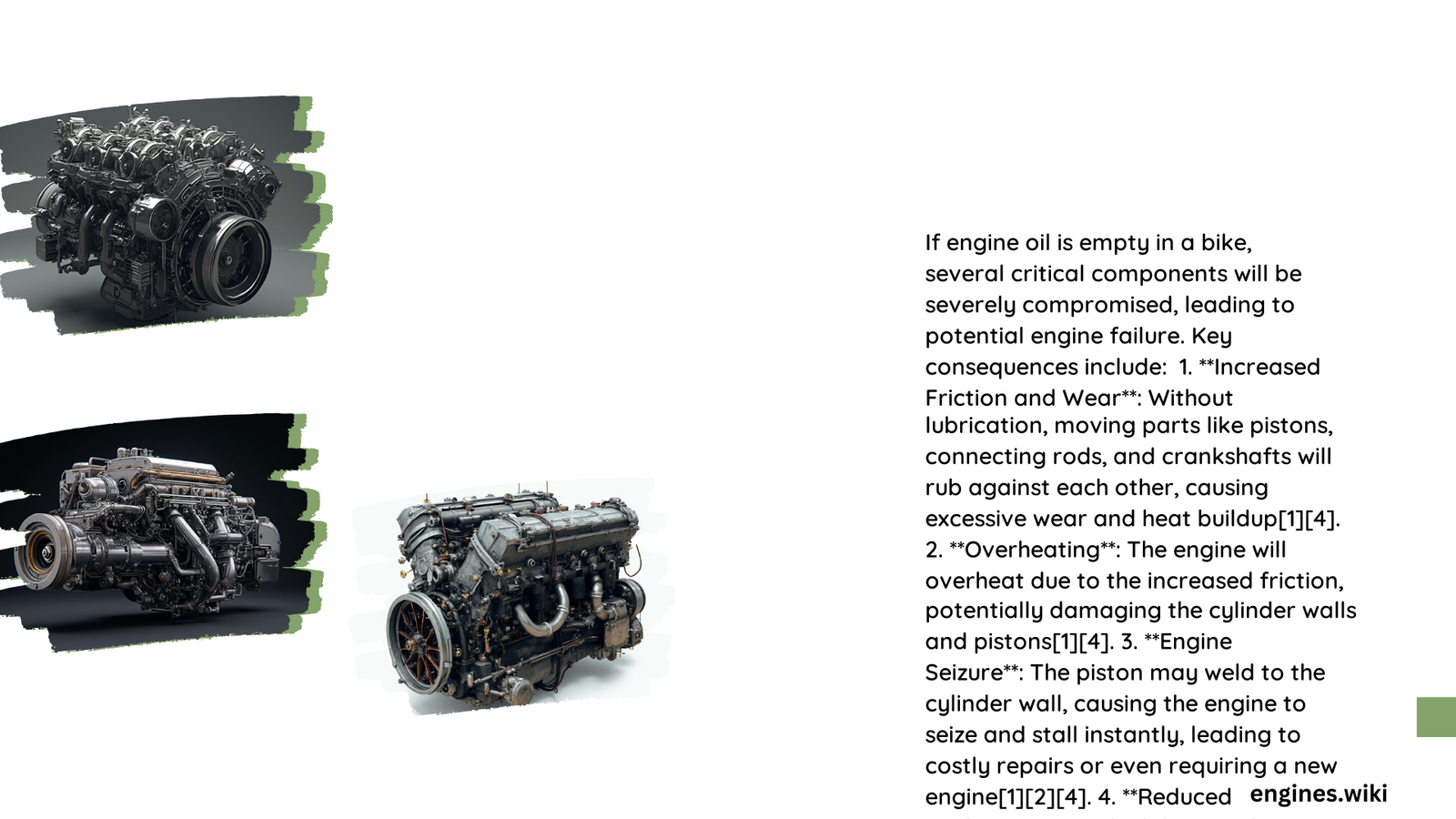Running a motorcycle with empty engine oil can lead to catastrophic consequences. The absence of lubricant causes metal-to-metal contact, rapid overheating, and severe wear on critical components. This results in scoring of cylinder walls, piston damage, and potential engine seizure. The effects manifest quickly, with initial damage occurring within minutes. Symptoms include unusual noises, loss of power, and eventual engine failure. Repairs can be costly, often requiring a complete engine rebuild or replacement.
What Are the Immediate Consequences of Running a Bike Without Oil?
When a motorcycle’s engine oil runs empty, several critical issues arise immediately:
- Metal-to-Metal Contact: Without the protective oil film, engine components directly rub against each other, causing rapid wear.
- Overheating: Oil plays a crucial role in heat dissipation. Its absence leads to a rapid temperature increase.
- Increased Friction: The lack of lubrication dramatically increases friction between moving parts.
- Accelerated Wear: Engine components experience exponential wear rates without proper lubrication.
The severity of these consequences cannot be overstated. Even a short period of operation without oil can cause irreversible damage to your motorcycle’s engine.
How Quickly Does Engine Damage Occur Without Oil?

The timeline of engine damage without oil is alarmingly short:
- Within Seconds: Metal-to-metal contact begins immediately.
- Within Minutes: Significant wear and scoring of engine components start to occur.
- Within 15-30 Minutes: Severe damage leading to potential engine seizure can happen.
It’s crucial to understand that the exact timeframe can vary based on factors such as engine design, operating conditions, and initial state of the engine. However, the consensus is clear – damage occurs rapidly and can be catastrophic.
What Are the Specific Components Affected by Oil Starvation?
Oil starvation affects various engine components, but some are more vulnerable than others:
- Bearings: Main and crankpin journal bearings are often the first to fail.
- Pistons and Cylinders: These suffer from scoring and gouging due to direct metal contact.
- Camshafts: Can experience significant wear on lobes and journals.
- Valvetrain Components: Valve guides, lifters, and rocker arms can be severely damaged.
Here’s a table summarizing the components and their vulnerability to oil starvation:
| Component | Vulnerability Level | Primary Damage |
|---|---|---|
| Bearings | Very High | Scoring, melting |
| Pistons/Cylinders | High | Scoring, seizure |
| Camshafts | High | Lobe wear, seizure |
| Valvetrain | Medium to High | Excessive wear, sticking |
How Does Oil Starvation Manifest in Engine Performance?
As oil starvation progresses, you’ll notice several performance issues:
- Unusual Noises: Expect to hear knocking, rattling, or grinding sounds.
- Power Loss: The engine will lose power and may struggle to maintain speed.
- Increased Vibration: As components wear, the engine’s balance is affected, leading to more vibration.
- Overheating: The engine temperature will rise rapidly, potentially triggering warning lights.
- Sudden Seizure: In severe cases, the engine may seize completely, causing immediate shutdown.
These symptoms typically progress rapidly. If you notice any of these signs, it’s crucial to stop the engine immediately to prevent further damage.
What Are the Long-Term Effects of Running a Bike Without Oil?
Even if an engine survives a brief period of oil starvation, long-term effects can include:
- Reduced Engine Lifespan: The wear incurred during oil starvation can significantly shorten the engine’s overall lifespan.
- Decreased Performance: The engine may never regain its original performance levels.
- Increased Oil Consumption: Damaged piston rings and cylinder walls can lead to higher oil consumption.
- Recurring Issues: The initial damage can lead to ongoing problems, even after oil is replenished.
It’s important to note that these long-term effects can manifest even if the engine doesn’t fail immediately during the oil starvation event.
How Much Does It Cost to Repair Engine Damage from Oil Starvation?
The cost of repairing engine damage caused by oil starvation can be substantial:
- Minor Damage: $500 – $1,500 (e.g., replacing bearings)
- Moderate Damage: $1,500 – $3,000 (e.g., cylinder honing, piston replacement)
- Severe Damage: $3,000 – $7,000+ (complete engine rebuild or replacement)
Labor costs typically range from $100 to $150 per hour, with repairs taking anywhere from 10 to 40 hours depending on the extent of the damage.
How Can You Prevent Oil Starvation in Your Motorcycle?
Preventing oil starvation is crucial for maintaining your motorcycle’s engine health:
- Regular Oil Checks: Check your oil level before every ride.
- Adhere to Maintenance Schedules: Follow manufacturer-recommended oil change intervals.
- Use Quality Oil: Always use the recommended grade and type of oil for your bike.
- Address Leaks Promptly: Fix any oil leaks as soon as they’re detected.
- Monitor Oil Pressure: Pay attention to oil pressure gauges or warning lights.
By following these preventive measures, you can significantly reduce the risk of oil starvation and protect your engine from catastrophic damage.
What Are the Warning Signs of Low Oil in a Motorcycle?
Recognizing the warning signs of low oil can help prevent severe engine damage:
- Oil Pressure Warning Light: This is often the first indicator of low oil levels.
- Unusual Engine Noises: Ticking or knocking sounds can indicate insufficient lubrication.
- Decreased Performance: Loss of power or sluggish acceleration may occur.
- Burning Smell: The smell of burning oil can indicate low levels or leaks.
- Visible Oil Leaks: Check for oil spots under your parked motorcycle.
If you notice any of these signs, stop riding immediately and check your oil levels. Continuing to ride with low oil can quickly lead to the severe consequences discussed earlier.
Remember, maintaining proper oil levels is one of the most critical aspects of motorcycle maintenance. Regular checks and timely oil changes can save you from expensive repairs and extend the life of your engine.
References:
1. https://ridersrecycle.com/blog/engine-autopsy-1-what-happens-when-a-bike-is-starved-for-oil/
2. https://www.svrider.com/threads/oil-starvation-what-goes-first.107930/
3. https://bobistheoilguy.com/forums/threads/wheelies-and-oil-starvation.122040/
